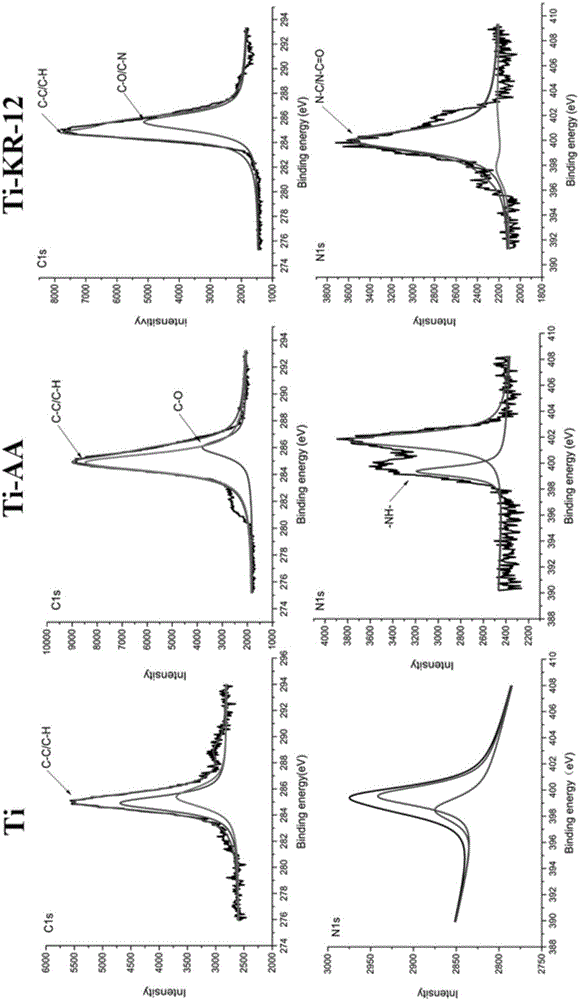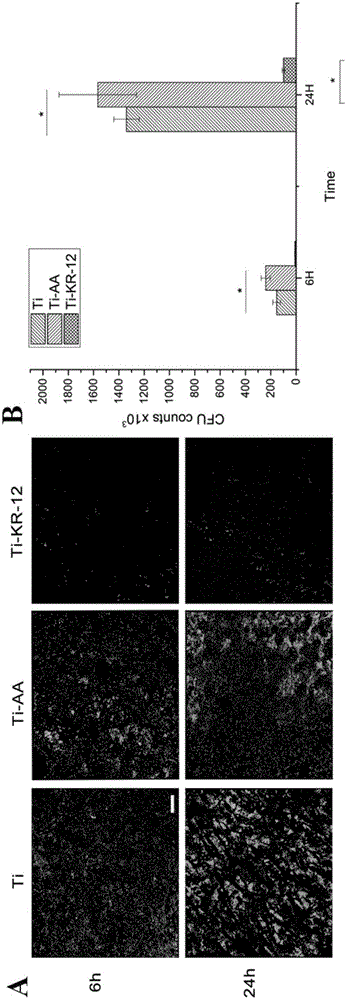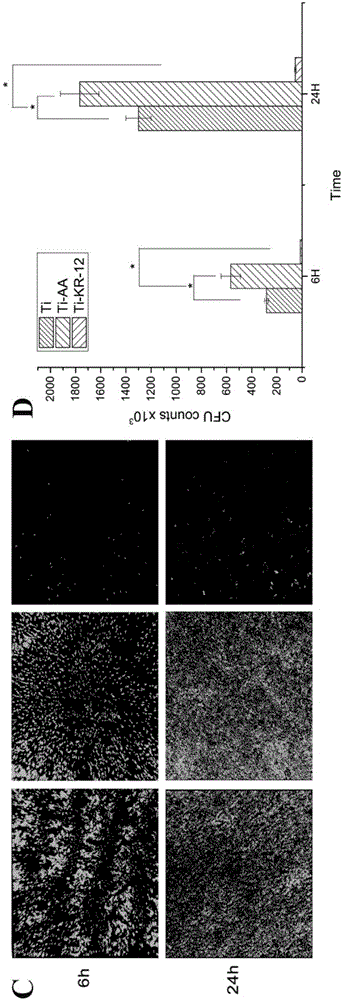Infection preventing and osteoblast differentiation promoting antibacterial peptide modified titanium alloy prosthesis and making method thereof
An osteogenic differentiation, titanium alloy technology, applied in the direction of prosthesis, pharmaceutical formulation, medical science, etc., can solve the problems of loosening and infection, and achieve the effect of low cost, good repeatability and excellent antibacterial biological activity.
- Summary
- Abstract
- Description
- Claims
- Application Information
AI Technical Summary
Problems solved by technology
Method used
Image
Examples
Embodiment 1
[0036] Example 1 Preparation of the antimicrobial peptide-modified titanium alloy prosthesis of the present invention (1)
[0037] 1. Preparation of antimicrobial peptide KR-12
[0038] Antibacterial peptide KR-12 was synthesized by solid-phase synthesis, and its amino acid sequence was: KRIVQRIKDFLR (SEQ ID NO. 1). The purity of KR-12 antimicrobial peptide is above 95%.
[0039] 2. Introduction of functional functional group amino group on the surface of titanium sheet
[0040]A functional functional group amino group was introduced on the surface of the titanium sheet by a two-step method. First, the titanium sheet was subjected to alkali treatment to introduce a hydroxyl group, and then a silanization treatment was performed to introduce an amino group. Specifically: first, immerse a titanium alloy disc (Ti6Al4V, Ti, φ10×2mm, Shanghai Yan Titanium Metal Materials Co., Ltd.) into a beaker containing a strong alkali solution with a concentration of 5M, seal the beaker with ...
Embodiment 2
[0060] Example 2 Preparation of the antimicrobial peptide-modified titanium alloy prosthesis of the present invention (2)
[0061] 1. Preparation of antimicrobial peptide KR-12
[0062] Same as Example 1.
[0063] 2. Introduction of functional functional group amino group on the surface of titanium sheet
[0064]A functional functional group amino group was introduced on the surface of the titanium sheet by a two-step method. First, the titanium sheet was subjected to alkali treatment to introduce a hydroxyl group, and then a silanization treatment was performed to introduce an amino group. Specifically: first, immerse a titanium alloy disc (Ti6Al4V, Ti, φ10×2mm, Shanghai Yan Titanium Metal Materials Co., Ltd.) into a beaker containing a strong alkali solution with a concentration of 10M, seal the beaker with plastic wrap, and oil it at 60°C. Bath reaction 8h. Then take out the titanium sheet and ultrasonically clean it twice with deionized water for 2 min each time. After ...
Embodiment 3
[0067] Example 3 Preparation of the antimicrobial peptide-modified titanium alloy prosthesis of the present invention (3)
[0068] 1. Preparation of antimicrobial peptide KR-12
[0069] Same as Example 1.
[0070] 2. Introduction of functional functional group amino group on the surface of titanium sheet
[0071] A functional functional group amino group was introduced on the surface of the titanium sheet by a two-step method. First, the titanium sheet was subjected to alkali treatment to introduce a hydroxyl group, and then a silanization treatment was performed to introduce an amino group. Specifically: first, immerse a titanium alloy disc (Ti6Al4V, Ti, φ10×2mm, Shanghai Yan Titanium Metal Materials Co., Ltd.) into a beaker containing a strong alkali solution with a concentration of 8M, seal the beaker with plastic wrap, and oil at 70 ° C Bath reaction for 10h. Then take out the titanium sheet and ultrasonically clean it twice with deionized water for 2 min each time. Aft...
PUM
 Login to View More
Login to View More Abstract
Description
Claims
Application Information
 Login to View More
Login to View More - R&D
- Intellectual Property
- Life Sciences
- Materials
- Tech Scout
- Unparalleled Data Quality
- Higher Quality Content
- 60% Fewer Hallucinations
Browse by: Latest US Patents, China's latest patents, Technical Efficacy Thesaurus, Application Domain, Technology Topic, Popular Technical Reports.
© 2025 PatSnap. All rights reserved.Legal|Privacy policy|Modern Slavery Act Transparency Statement|Sitemap|About US| Contact US: help@patsnap.com



